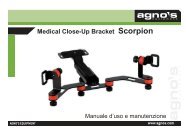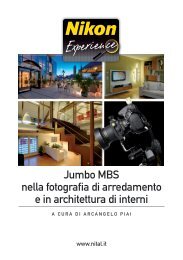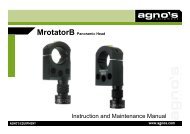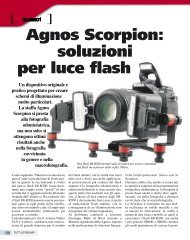Agno's Mrotator TCPshort â Canon 5d/ Sigma 8mm Lens
Agno's Mrotator TCPshort â Canon 5d/ Sigma 8mm Lens
Agno's Mrotator TCPshort â Canon 5d/ Sigma 8mm Lens
You also want an ePaper? Increase the reach of your titles
YUMPU automatically turns print PDFs into web optimized ePapers that Google loves.
Agno’s <strong>Mrotator</strong> <strong>TCPshort</strong> – <strong>Canon</strong> <strong>5d</strong>/ <strong>Sigma</strong> <strong>8mm</strong> <strong>Lens</strong><br />
Test Report: June 2006<br />
Introduction: The L shaped panorama bracket and rotator base are designed to<br />
accommodate most types of film and digital cameras. It provides a method for<br />
capturing single or multiple row images suitable for creating cylindrical, cubic and<br />
spherical panoramic image. This report uses the <strong>Canon</strong> <strong>5d</strong> and <strong>Sigma</strong> <strong>8mm</strong><br />
fisheye lens.<br />
Specifications: Agno’s <strong>Mrotator</strong> <strong>TCPshort</strong> Kit. The kit includes <strong>Mrotator</strong> TB<br />
rotator base, L bracket and a camera standard Manfrotto quick change rectangle<br />
adapter plate. The adapter plate is similar to Manfrotto product nr. 3299.<br />
Together the Base * and bracket are 17cm wide x 13cm deep (arm piece) x 29cm<br />
high (7”w x 5”d x 11”h). The combined rotator and bracket weight is 1.44kg or<br />
3.17 lbs. The product has black knobs and black protective paint finish. The L<br />
bracket and arm have index scales. The bracket base has a 17mm diameter<br />
round yellow/green spirit level.<br />
* The <strong>Mrotator</strong> TB base is 7<strong>8mm</strong> high x 60mm diameter (3”high x 2 ¼” diameter) and is .43kg or 1 lb.<br />
Design Features: The <strong>Mrotator</strong> <strong>TCPshort</strong> can be separated into 2 pieces allowing for easy travel<br />
storage. All the alignment control knobs are with in easy reach while standing from behind. Location of<br />
the control knobs and spirit level (if mounted on the back side) are easy to read and understand.<br />
1
Setup Procedure: Place the Manfrotto 488RC2 ball head on a Manfrotto 3001d tripod. Place the<br />
assembled <strong>Mrotator</strong> <strong>TCPshort</strong> on the ball head quick release plate.<br />
Removing left/right parallax. Parallax is the apparent change in the position of an object that results in<br />
change in the point of view. It is necessary to align the camera on the panorama head to view the object<br />
from the exact same position. Rotate the camera so the lens points directly DOWN. Loosen the <strong>Mrotator</strong><br />
<strong>TCPshort</strong> horizontal bracket knob (see above photo) and gently slide the bracket until the camera’s view<br />
finder “Center” focus box is lined up directly over the top of the tripod’s center rotation point. We found the<br />
lens center at 42* on the head horizon scale. See the alternate marking method 28*. This should<br />
eliminate parallax.<br />
Find Entrance Pupil [Nodal Point] location.<br />
The nodal point (NP) location is a function of the lens and not the<br />
camera. It is the position inside the lens where the incoming image<br />
is inverted and projected back to the film plane or sensor.<br />
We found the <strong>Sigma</strong> <strong>8mm</strong> NP to be at the gold ring marker. Place<br />
the gold ring directly over the top of the tripod’s rotation point. We<br />
found that fisheye lenses typical have more than 1 NP, depending<br />
on the closest object in front of the lens. The gold ring is a good<br />
starting location. We found the center point to be around 20* on the<br />
horizontal arm (with camera ) index scale.<br />
*Scale markings shown represent a good starting point.<br />
2
(Finding Entrance Pupil [Nodal Point] location continued)<br />
After you have put the gold ring over the tripod center then set the precision (NP) nodal point using the<br />
photo’s below. We used a block of 6 x 6” foam. We put 2 white wires in opposite corners. The two<br />
white sticks should not appear move when you rotate the camera about 45° left and right.<br />
Taking the Panorama Photos<br />
Using the spirit level, setup the tripod and <strong>Mrotator</strong> <strong>TCPshort</strong> bracket. Now it is time to take your images.<br />
Take 4 images at 90° intervals. The <strong>Canon</strong> <strong>5d</strong> has a full sensor so all image data fits on the sensor.<br />
Photographs<br />
1 2 3 4<br />
1 2 3 4<br />
Stitch the 4 images with your favorite stitching software. Then while viewing it on screen tilt down.<br />
3
The tripod cap should look like this:<br />
The <strong>Mrotator</strong> <strong>TCPshort</strong> design keeps all the bracket parts outside the <strong>Sigma</strong> <strong>8mm</strong> 180° lens viewing<br />
area. This pan head has a very small footprint.<br />
If your pan head appears like in the photo, you have done a good job in locating the Entrance Pupil or<br />
Nodal point. Your stitching should be near perfect. The red construction lines show where the 4 images<br />
are overlapping at the bottom of the image<br />
4
Zenith<br />
Nadir<br />
The <strong>Mrotator</strong> <strong>TCPshort</strong> does tilt 90° up (zenith) and down (see nadir above). Usually we only take 4<br />
images on the horizon. Now with the <strong>Mrotator</strong> <strong>TCPshort</strong> we take 4 +1 up Zenith. The down Nadir shot is<br />
optional.<br />
Finished panorama<br />
This finished panorama contains hard visual lines. A good correct alignment test is hard line convergence<br />
in the top 10%, mid 60 % of the image. Precision <strong>Mrotator</strong> <strong>TCPshort</strong> panorama head with correct<br />
alignment will produce an excellent result.<br />
Our testing equipment:<br />
Camera: <strong>Canon</strong> <strong>5d</strong> (full 35mm sensor 35.<strong>8mm</strong> x 23.9mm) Body .810kg or 26.6oz<br />
Compact Flash Card: 1 GB Lexar Media Professional 80x WA (also had 256mb compact flash card)<br />
Prime <strong>Lens</strong>: <strong>Sigma</strong> <strong>8mm</strong> Fisheye 4:1 EX .320kg or 11.3oz<br />
Images: <strong>Canon</strong> CR2 RAW<br />
Pan Head: Agno’s <strong>Mrotator</strong> <strong>TCPshort</strong> 1.44kg or 15.2oz<br />
Support: Manfrotto/ Bogen Ball Head 488CR2 (supports 17.6 lbs) .67kg or 23oz<br />
Tripod: Manfrotto/ Bogen 3001d with 3/8” or ¼”-20 thread center screw<br />
Total Weight: approximate 12 lbs or 5.44 kg<br />
5
Conclusion<br />
Qualities:<br />
The <strong>Mrotator</strong> <strong>TCPshort</strong> design makes it easy to align the camera and lens so that you will get repeated<br />
“NO error” type stitched images. Take precision single photo’s the first time and your stitched panorama<br />
should be almost error free.<br />
Normally all controls are at the back of the camera. The <strong>Mrotator</strong> <strong>TCPshort</strong> alignment knobs are also<br />
easily accessed from the back side of the tripod. This means you can stand in one location and make ALL<br />
the adjustments. This prevents accidentally hitting a tripod leg.<br />
Rotating through the <strong>Mrotator</strong> TB click stops is very easy. The clicking sound and feel are solid.<br />
Using the Manfrotto Quick Change Plate adapter (US Nr. 3299) is a great idea. It permits removing and<br />
re-mounting the camera on the <strong>Mrotator</strong> <strong>TCPshort</strong> without having to realign the camera again. The<br />
camera plate portion of the Manfrotto 3299 remains on the camera base allowing re-use on another tripod<br />
or monopod.<br />
Suggestions:<br />
Total assembled tripod, ball head, <strong>Mrotator</strong> <strong>TCPshort</strong> pan head, are made of steel and aluminum<br />
material. The rotator base is master crafted aluminum for accurate rotation. The L-Bracket is master<br />
crafted, precision cut and formed structural steel that assures the camera and lens will be properly<br />
supported during the imaging process. Together the <strong>Mrotator</strong> TB rotator base and meticulousness formed<br />
bracket will assure exact positioned imaging.<br />
A small knob obstruction was seen in the <strong>Sigma</strong> 8 full 180° view. This is NOT a <strong>Canon</strong> <strong>5d</strong> stitching issue.<br />
Recommendation: Excellent panoramic hardware.<br />
6








